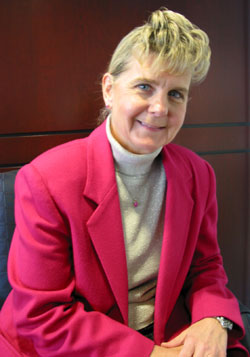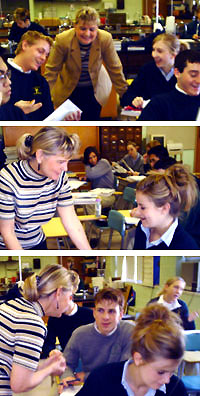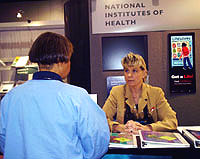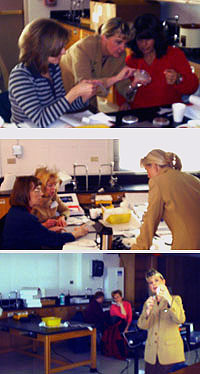 |
 |

|
|
Peggy Deichstetter, M. Ed., M.S.W., Biology Teacher, Saint Edward High School, Elgin, Illinois
|
1. I chose this career because...
2. My typical workday involves...
3. I came to the National Institutes of Health (NIH) because...
4. What I like best/least about my job...
5. My career goals are...
6. When I'm not working, I like to...
7. Mom's advice to me...
|
|
1. I chose this career because...
|
Back to Top

|

|
|
Peggy Deichstetter works with students in her classroom at Saint Edward High School, Elgin, Illinois
|
I chose to become a biology teacher because I have always been interested in biology, especially in the study of the human body. One Christmas, I asked Santa for The Visible Man - a plastic mannequin that has removable organs. I put it together and painted all the parts. At this early age, I was sure I wanted to be a nurse.
At the age of 15, I became a Candy Striper to further test my interest in the field of nursing. It was not what I wanted. I stuck with it for the year, but I determined that nursing was not for me after all. From sophomore to senior year, I flitted from one career to another. During my senior year, my physics teacher developed laryngitis. She asked me to fill-in for her and teach her geometry class. I did it, and loved it. That experience, couple with my love of biology, prompted me to pursue a career as a biology teacher.
A Dual Career Path
In 1978, I took on a new challenge and decided to pursue a degree in counseling. A friend convinced me that a Master of Social Work was a very versatile degree. After receiving my Master's Degree, I spent the next 15 years with dual careers in counseling and teaching biology. I returned to the classroom full-time in 1997.
Education
- Associate of Arts, Social Science, Triton Community College, River Grove, Illinois
- Bachelor of Science in Education, Comprehensive major in Biology, Northern Illinois University, Dekalb, Illinois
- Master of Education, Psychology of Education, National Louis University, Evanston, Illinois
- Master of Social Work, Psychiatric Counseling, specializing in adolescents, Loyola University, Chicago, Illinois
|
|
2. My typical workday involves...
|
Back to Top

|

|
|
Peggy Deichstetter explains scientific concepts to individual students.
|
My typical workday is divided into classroom periods 1 through 8. A typical classroom period lasts about 45 minutes, and is a division of time to focus on one particular subject or activity. I teach grades 9 and 10 honors biology, grade 10 biology, and grades 10 – 12 microbiology and genetics.
Morning Preparation
I get to school between 7:00-7:15 and prepare for the day’s labs. This includes sterilizing materials if necessary, and putting out any other materials that will be needed for the 1st period lab.
1st and 2nd Periods
This is a double lab period that begins at 8:10AM and lasts 90 minutes. My tasks are to:
- Discuss the lab procedures for the day, develop a hypothesis and design the experiment
- Review relevant background information to ensure students understand the purpose of the lab experiments
- Demonstrate lab techniques and explain how to use equipment if needed
- Assist students and answer questions as they complete lab work
3rd Period
I usually divide this period into three different stages by time and activity, as follows:
- First 15 minutes – quiz on a reading assignment or previous day’s lesson
- Next 15-20 minutes - activity to demonstrate a concept
- Final 10-15 minutes - relate studied concept to real life situation
For example, I’ve had students use candy M&Ms to demonstrate how natural selection works. The losers are eaten; while the strongest go on to compete again. After the activity, students review their data and discuss the outcome. They learn that the strongest M&M will live to reproduce more of the same color and attributes, a central principle behind the theory of natural selection. After that, we discuss how natural selection relates to the real-life problem of emerging diseases.
4th Period
I use this time to clean-up and put away materials from my earlier labs. I also prepare for my 5th and 6th period biology classes.
5th and 6th Periods
I usually divide these periods into 3 twenty-minute activities, similar to 3rd period. For example, a class on blood typing may proceed as follows:
- First twenty minutes - a quiz on the homework reading assignment
- Next twenty minutes - students use building toys to demonstrate how blood typing works
- Final twenty minutes - students are challenged to find the mugger who left his blood at the crime scene. They use fake blood to do blood typing, and use Punnett squares to pinpoint the perpetrator.
Lunch Break
During my twenty-two minute lunch break, I put away the materials from biology class, eat lunch, and prepare for my 7th period microbiology class.
7th Period
This period is for my microbiology class, a hands-on lab-based junior/senior elective. This period is generally spent doing an experiment. For example, students might explore how antibiotics work. Through experiments and results, students learn that different antibiotics affect different bacteria. Finally, we discuss how the incorrect use of antibiotics leads to antibiotic-resistant bacteria.
8th Period
I use this period to do a variety of tasks like:
- Clean-up from microbiology class
- Make tests, worksheets or activities
- Photocopy materials for distribution to students
- Score tests previously given
Workday’s End
Before I leave work, I make sure everything is ready for the next day. I may stay late to help a student who doesn’t understand something, or who missed school. Sometimes a parent may come by to talk about their child’s progress. I generally leave school between 3:30 and 4:00PM.
Evenings and Weekends
A good deal of time outside the classroom is spent correcting students’ work, keeping track of grades, and keeping current on developments in science. Professional development is an important aspect of remaining current in science. I attend and sometimes present at many science conferences. For example, I recently presented a microbiology workshop at the Kane County Regional Institute.
Equipment I Use
One of the challenges of being a teacher is creating your own special equipment. K-Nex and Velcro are great “build it yourself” toys. I use them to make models to help my students visualize how something works. For example, I used K-Nex and Velcro to build Y shapes to demonstrate how antibodies work.
Additional Roles
As a teacher, I have many additional roles at my school. I mentor students with their science projects, and serve as a judge at science fairs. Some students look to me for personal advice. As a teacher, counselor, and mother myself, I am happy to fill this role. I’m also the prom co-coordinator. It is my job to organize the prom committee and keep them on task. (It’s a bit like organizing a wedding every year, but with 15-20 brides wanting it theirway.)
|
|
3. I came to the National Institutes of Health (NIH) because...
|
Back to Top

|

|
|
Peggy Deichstetter talks to a teacher about the NIH Curriculum Supplements at the National Science Teachers Association convention in Atlanta, Georgia.
|
In 2003, I came to the NIH as an Albert Einstein Educator Fellow http://www.scied.science.doe.gov/scied/Einstein/about.htm. I live in Washington D.C. and work in the Office of Science Education (OSE) at the NIH. The experience has been a dream come true.
My job here includes a great deal of travel to major conferences for professional development activities. I work with OSE staff at these conferences to train teachers how to use the NIH Curriculum Supplements (http://science.education.nih.gov/supplements/). I have learned so much about the NIH and the federal government. I’ve learned how the supplements are developed and field tested, and discovered activities that will be useful to my students. At the OSE, I have contributed to the development of new education materials by sharing my many years of first-hand classroom experience.
|
|
4. What I like best/least about my job...
|
Back to Top

|

|
|
Peggy Deichstetter conducts professional development training for high school biology teachers.
|
What I like best about my job is the opportunity to work with the students, and to see the "light bulb go on over their heads" when they suddenly understand something new.
One of the best parts of my job is a two-week Marine Science Seminar in Hawaii that I attend with my students each year. This is a life-changing activity for my students. They learn marine science and Hawaiian culture and lore. They also get a chance to see what it is like being away from home and living in a dorm setting.
What I like least about my work is work-related politics. For example, some teachers will get better schedules or classes because they “campaign” for what they want. To me, that is a waste of time. I also dislike doing tasks that have nothing to do with helping students, like working on committees, such as a committee to design a new schedule.
|
|
5. My career goals are...
|
Back to Top

|
My career goal is to become Outstanding Biology Teacher of Illinois. I have been a finalist for the last two years and feel the challenge hones my classroom skills. Goals like that help me to focus on being the best teacher I can be. Recently, I achieved one of my long-standing goals - to become a nationally board-certified science teacher.
|
|
6. When I'm not working, I like to...
|
Back to Top

|
When I’m not working, I like to travel and go scuba diving with my husband. Once we spent a month in Australia, diving the Barrier Reef and camping in the Outback. I like gourmet cooking and cake decorating. I really enjoy the challenge of designing and building wedding cakes. I also love working on a new lesson, toy or activity that will help my students learn.
|
|
7. Mom's advice to me...
|
Back to Top

|
From sophomore to senior year I had a lot of ideas about which careers to pursue. One idea was to become an archaeologist. My mother wisely handed me the Want Ads of the local newspaper and asked me, “How many ads for archaeologists can you find?” I couldn’t find any.
|
|
|
|
 |